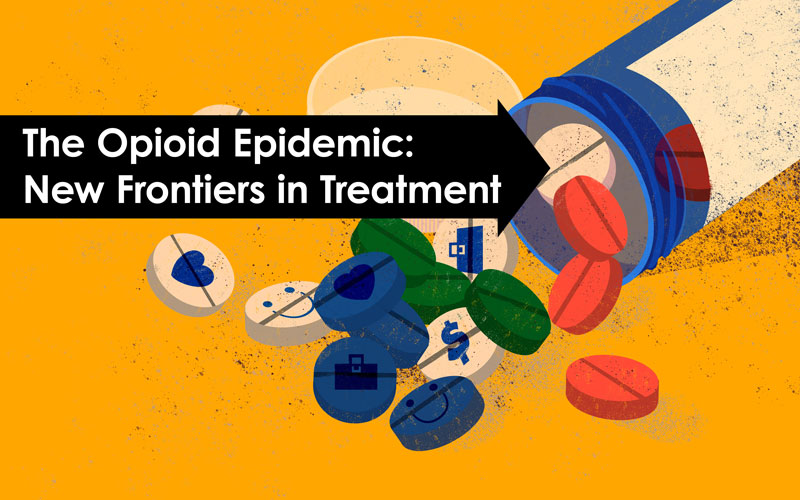From 1999-2019, according to the Centers for Disease Control and Prevention (CDC), nearly 500,000 people died from an overdose involving prescription or illicit opioids. Opioid overdose was responsible for nearly 80,000 deaths in 2023 in the United States (KFF, 2023). There are medications to reverse an overdose and medications to treat Opiod Use Disorder (OUD) to some degree. A new medication class that may be more effective than opioids at treating acute pain is now approved by the Food and Drug Administration (FDA). Most encouraging is a class of drugs initially intended to treat diabetes that has already been noted to have the fortunate side-effect of decreasing addictive behaviors.

Current OUD Treatments Fall Short: A Call for Better Options
Nationally, more than three million people meet the criteria for OUD (Dydyk, 2024). Medications for treatment of OUD are limited currently to buprenorphine, naltrexone, and methadone but have significant relapse rates, are not as effective in patients who have used synthetic opioids like Fentanyl, and are sometimes stigmatized as simply trading one opioid for another. Additional treatment options include cognitive behavioral therapy, exercise, and other complementary therapies such as acupuncture, yoga, tai-chi, or massage, but none are viewed as a cure to the epidemic. Implantable devices, radiofrequency ablations, and other invasive therapies are less frequently used to treat pain and not easily accessible for all patients. There is little debate that new treatments are needed.
FDA Approves First Non-Opioid Analgesic in 20 Years
Journavx (suzetrigine) is a first in its class sodium channel blocker for acute pain management. It is a non-opioid analgesic used for moderate to severe pain and the first new pain medication approved by the FDA in 20 years (FDA, 2025). Dosing is not too complicated—starting at two pills initially, then one every 12 hours for three doses, then once every 24 hours—and appears to be well tolerated. It has not been studied for more than 14 days of use, but if it is effective and stops the development of dependence on narcotic medication, it would be an important step in decreasing the opioid epidemic.
GLP-1 Drugs: The Surprising Ally in Addiction Recovery
Most promising is the use of glucagon-like peptide-1 receptor agonists (GLP-1) class of drugs. GLP-1s are already prescribed to millions and have a demonstrated track record of safety in patients with a variety of addictions, including those with OUD but also those with other addictions, as well as mental health diagnoses like anxiety and depression. In patients with a concurrent alcohol use disorder, GLP-1s are being shown to prevent relapse and are demonstrated to be safe when adding to existing anti-addiction treatments (Wang, 2024). Anecdotal evidence and studies have shown that GLP-1s are effective in reducing cravings and produce an anti-addictive side effect. As reported by the non-profit organization CASPR, this appears so clear that many physicians are already prescribing these medications as an off-label use for patients with Substance Use Disorder (SUD) more broadly, not just for OUD (Sarhan, 2024). Mounting evidence continues to show that GLP-1 drugs may also be effective for a wide range of mental health factors, with many patients seeing improvements in anxiety and depression as well as reductions in suicidal ideation and suicide attempts.
GLP-1s in the Fight Against Addiction
In the battle against the opioid epidemic, GLP-1s are showing great promise. They are demonstrated to be safe taken concurrently with other medication treatment while also producing side effects that reduce addiction cravings. They may very well prove to be a non-opioid therapy with the potential to transform the treatment of addiction.

Advance Your Clinical Knowledge—Access These Courses with Your Subscription
For healthcare professionals addressing the opioid crisis, staying informed is critical. These accredited continuing education courses—included in all CareerSmart Learning subscriptions—offer timely, evidence-based content to support effective care delivery:
- Opioid Crisis Management (3.0 CE Hours): Analyze the origins, impact, and multidisciplinary strategies for managing the opioid epidemic.
- Substance Use Disorder (2.5 CE Hours): Examine clinical approaches to treating substance use disorders and their intersection with mental health.
- Our recent webinar, “Reframing the Pain Conversation: Debunking Myths in Opioid and Chronic Pain Management,” will soon be available as a CE course. Until then, review the Webinar Q&A Recap for expert insights.
To access these and other CE opportunities, select your subscription and enhance your professional impact today.
References:
Centers for Disease Control (CDC). Uncovering the Opioid Epidemic. https://www.cdc.gov/museum/pdf/cdcm-pha-stem-uncovering-the-opioid-epidemic-lesson.pdf
Kaiser Family Foundation (KFF). Opioid Overdose Deaths as a Percent of All Drug Overdose Deaths. 2023. https://www.kff.org/mental-health/state-indicator/opioid-overdose-deaths/?currentTimeframe=0&sortModel={“colId”:”Location”,”sort”:”asc”}
Dydyk AM, Jain NK, Gupta M. Opioid Use Disorder: Evaluation and Management. [Updated 2024 Jan 17]. In: StatPearls [Internet]. Treasure Island (FL): StatPearls Publishing; 2025 Jan-. Available from: https://www.ncbi.nlm.nih.gov/books/NBK553166/
Wang, W., Volkow, N.D., Berger, N.A. et al. Associations of semaglutide with incidence and recurrence of alcohol use disorder in real-world population. Nat Commun 15, 4548 (2024). https://doi.org/10.1038/s41467-024-48780-6
Sarhan, Mo. How an addiction medicine doctor has made GLP-1s like Ozempic central to this practice. Sept. 26, 2024. https://recursiveadaptation.com/p/how-an-addiction-medicine-doctor
U.S. Food and Drug Administration (FDA). FDA Approves Novel Non-Opioid Treatment for Moderate to Severe Acute Pain. Jan. 30, 2025. https://www.fda.gov/news-events/press-announcements/fda-approves-novel-non-opioid-treatment-moderate-severe-acute-pain


